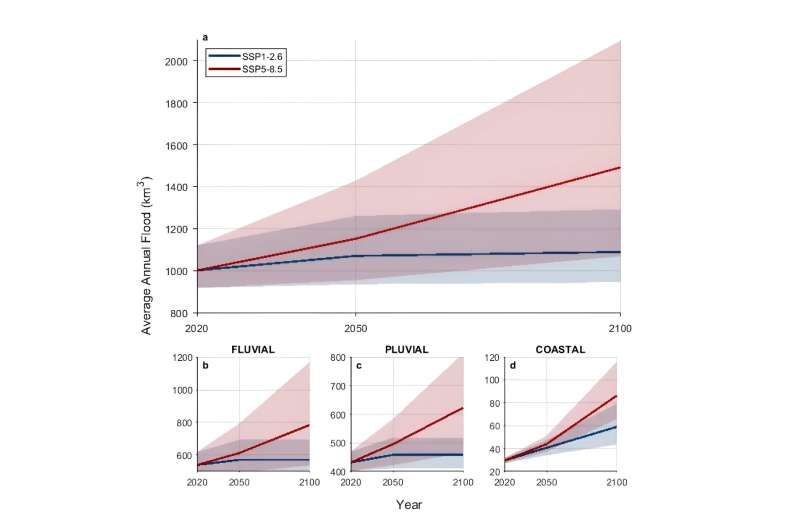
A graph showing the change in global flood hazard under low (SSP1-2.6) and high (SSP5-8.5) climate scenarios, expressed as the sum of A total flood, B fluvial (river), C pluvial (precipitation) and D coastal flood. Shading represents the likely range (17-83% probability) based on climatological uncertainty (i.e. uncertainty in the historical base period and associated warming, and in the modelled future changes from the different climate models). Image credit: University of Bristol
Groundbreaking research suggests that if countries fail to meet their official commitments to reduce carbon dioxide emissions, there will be significantly worse flooding around the world in the coming decades.
The study was conducted in Water resources research Led by experts from the University of Bristol and the global water risk information company Fathom, projections of different types of floods under different climate change scenarios are being produced with unprecedented precision.
Evidence from the use of a comprehensive mapping framework suggests that global floods could increase by about half between 2020 and the turn of the century if climate sensitivity is high and multilateral pledges to reduce carbon dioxide emissions are not met.
Lead author Dr Oliver Wing, Honorary Research Fellow at the Cabot Institute for the Environment, University of Bristol and Chief Research Officer at Fathom, said: “This research represents the culmination of years of research in our quest to future-proof communities around the world against the increasing risk of flooding. The results underline the importance of all countries keeping their pledges to reduce carbon emissions.”
In the best-case scenario of lower emissions, where all global carbon commitments are met, the average flood risk is expected to increase by 9 percent between 2020 and 2100. The more pessimistic projection of higher carbon emissions found that flood risk could increase by 49 percent by the end of the century.
In the coming decades, the projected increases in flood risk are smaller. In a low CO2 emissions scenario, the flood risk is expected to increase by 7% between 2020 and 2050. In a high CO2 emissions scenario, this value doubles to over 15%.
Dr Wing said: “It is important to note that these global averages are the result of projected changes in hazards, which show large geographical differences. In some places, flood risk will decrease, while in other places the increase will be several times higher than the global average, even under a lower emissions scenario.”
The report highlighted that coastal flooding will remain a hotspot whether or not all global carbon emissions are met. Even under a low-emissions scenario, coastal flooding is expected to almost double and increase by 99% by 2100, due to the lag in sea level rise responding to existing warming.
Floods caused by rainfall are particularly vulnerable to human-induced climate change, according to the study. While this type of flooding would increase by 6% by 2100 in a low-emissions scenario, this increase is 44% in a high-emissions model.
The largest future increases in flooding are expected along the world’s coasts and in tropical regions of Africa and Asia. There will also be significant changes in arid North Africa. The likelihood of increased flooding is highest along the North Atlantic and Indian Ocean coasts, as well as in Southeast Asia and the Pacific Islands.
Recently developed global flood models estimate the national or global population exposed to flooding, the potential value of assets at risk, the costs and benefits of flood protection measures, and the impacts of climate change and socioeconomic change on future losses. Most models only consider riverine flooding, but this study considers the significant impacts of coastal flooding and has undergone the most rigorous validation of any global flood model to date.
Countries signed ambitious commitments to reduce carbon emissions at COP27, but the study makes clear that flood levels are likely to be severely impacted if these commitments are not all met in time and in full.
Co-author Professor Paul Bates CBE, Professor of Hydrology at the Cabot Institute for the Environment, University of Bristol, and Chair and Co-Founder of Fathom, said: “In conducting this research project, we had to subject our findings to the most comprehensive benchmarking of global flood models ever published.”
“As our model delivers the highest resolution results to date, we hope it will also benefit the industry for a number of other use cases, such as protecting critical infrastructure from future floods, helping insurers price premiums, and meeting the requirements of climate regulations.”
Other contributors to the research from the University of Bristol include Prof. Jeff Neal, Professor of Hydrology at the Cabot Institute for the Environment, University of Bristol and Chief Scientific Advisor to Fathom, and two Fathom scientists who will soon begin their PhD studies at the university.
Further information:
Oliver EJ Wing et al, A global 30 m height flood model for each climate scenario, Water resources research (2024). research-information.bris.ac.u … every-climate-scenario
Provided by the University of Bristol
Quote: Research shows that reducing future global floods depends on reducing greenhouse gas emissions (21 August 2024), accessed 21 August 2024 from https://phys.org/news/2024-08-future-global-hinges-greenhouse-gas.html
This document is subject to copyright. Except for the purposes of private study or research, no part of it may be reproduced without written permission. The contents are for information purposes only.

